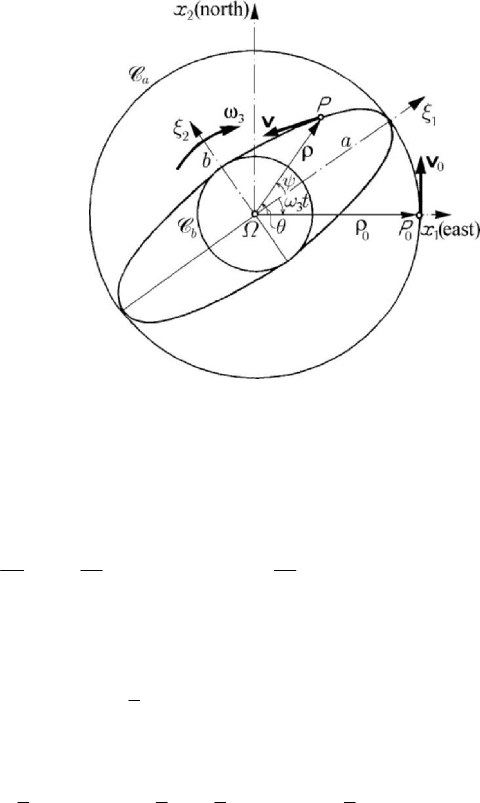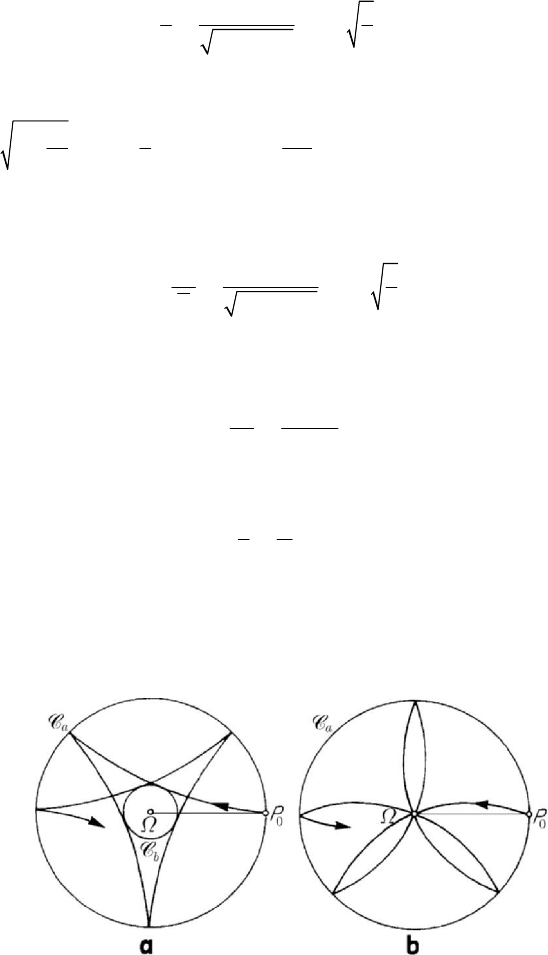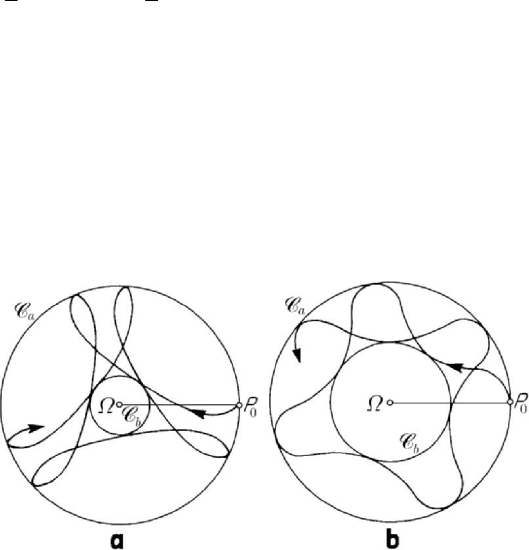Teodorescu P.P. Mechanical Systems, Classical Models Volume I: Particle Mechanics
Подождите немного. Документ загружается.


Other considerations on particle dynamics
653
2
3
2( )
r
vgxh=− + ,
3
(0)hx
=
− , (0) 0
r
v
=
. (10.2.63')
From (10.2.62'') it results (one introduces the sign minus, taking into account the
zone in which is the particle, Fig.10.15)
() ()
1/2
22 22
312 12
22
11
1 1 ...
2
xl xx l xx
ll
⎡⎤⎡ ⎤
=− − + =− − + +
⎢⎥⎢ ⎥
⎣⎦⎣ ⎦
.
We assume that the length
l is very large and that the mass m is sufficiently great.
The pendulum has a small displacement from its position of equilibrium
Ω , oscillating
without initial velocity with respect to the Earth; in this case, it effects small oscillations
around the position of equilibrium, which is a stable one. We can thus state that the
ratios
1
/xl and
2
/xl are very small (we say, generally, that they are of order of
magnitude
0ε > , that is
1
/()xl ε
=
O ,
2
/()xl ε
=
O ); it results
(
)
2
3
1xl ε=− +
⎡⎤
⎣⎦
O ,
(
)
2
1hl ε=− +
⎡
⎤
⎣
⎦
O and
(
)
2
3
hx ε+=O . From (10.2.62''),
(10.2.63'), we can write
++=
11 22 3 3
0xx xx xx
,
222
123 3
2( ) ()xxx ghx ε++=− + = O ,
so that
1
()x ε
=
O ,
2
()x ε= O ,
3
()x ε
=
O ,
(
)
2
33 11 22
///xx l xx l xx l ε=− − =O
and then
(
)
2
3
x ε= O . The tension T being of the order of unity, the first two
equations (10.2.62') show that we have at least
1
()x ε
=
O ,
2
()x ε= O .
Differentiating the relation (10.2.62'') once more with respect to time, we can write
(
)
(
)
222 2
3 3 123 1 1 2 2
(/) / (/) (/)xlx x x x l xlx xlx ε=− + + − − = O , so that
3
x
2
()ε= O . Using the previous evaluations and observing that, in this case,
3
xl≅− , the
third equation (10.2.62') leads to
Tmg
≅
, (10.2.64)
the tension in the thread being approximately equal to that corresponding to the position
of equilibrium.
Returning to the first two equations (10.2.62'), we find the equations of motion in the
plane
3
xl
=
− , tangent to the position of equilibrium Ω (which corresponds to small
oscillations around this stable position of equilibrium), in the form (we consider the
axes
1
xΩ and
2
xΩ parallel to the axes
1
Ox and
2
Ox , respectively; for the sake of
simplicity, we use the same notations for the co-ordinates)
112
2sin
g
xxx
l
ωλ=− + ,
221
2sin
g
xxx
l
ωλ=− − ; (10.2.65)
in a vector form, we get
3
2
g
l
=
−− ×
ρ
ρωρ, (10.2.65')

MECHANICAL SYSTEMS, CLASSICAL MODELS
654
where
333 3
sinωωλ
=
=iiω is the vector component of the rotation vector ω along
the local vertical, while
ρ is the position vector in the tangent plane. A vector product
by
ρ leads to (we have
3
0⋅=ρω )
()
()
2
333
dd
2( ) 2( )
ddtt
ρ×= × =− × × =− ⋅ =−
ρρ ρρ ρ ω ρ ρρω ω,
wherefrom
2
3
ρ×+ =
C
ρρ ω
,
const=
J
JJJJG
C , (10.2.66)
corresponding to a first integral of moment of momentum; scalarly, we have
(
)
22
12 21 1 2
sinxx xx x x Cωλ−++ =
, constC
=
. (10.2.66')
In polar co-ordinates
,ρθ, we may express the first integrals (10.2.63'), (10.2.66') in the
form
(
)
222
2( )
g
gl h
l
ρθρ++ = −
,
22
sin Cρθ ρω λ
+
=
, (10.2.67)
characterizing thus the motion in the plane
12
xxΩ .
We introduce a system of axes
12
Ωξ ξ , movable with respect to the system
12
xxΩ ,
which is rotating about the local vertical
3
Ox with the angular velocity
33
sinωλ−=− iω (in the sense north-east-south-west, hence clockwise). Taking into
account (10.2.1), (10.2.1') and starting from the equation (10.2.65'), we can write the
equation of motion of the particle
P with respect to this last movable frame in the form
[]
2
33 33 3
2
2()()()2()
g
lt
t
∂∂
=−− ×−−×−−×−×−−×
∂
∂
ρρ
ρωρ ω ρ ω ω ρ ω
,
where
/ t∂∂ρ and
22
/ t∂∂ρ are the relative velocity and acceleration, respectively. We
notice that
3
=
0ω and
3
d/d / ( )tt
=
=∂ ∂ + − ×
ρ
ρρ ωρ, so that (we have
3
0⋅=ρω )
2
2
2
()
g
l
t
ω
∂
=− + × × =−
∂
ρ
ρω ωρ ρ,
222
2
3
sin
gg
ll
ωωωλ=+ =+ . (10.2.68)
This is the equation of motion of a particle
P of mass m , attracted by the centre Ω
with an elastic force
(
)
22
2
sin
g
mm
l
ωωλ−=−+
ρ
ρ ; (10.2.68')

Other considerations on particle dynamics
655
hence, the trajectory is an ellipse or a segment of a line (degenerate ellipse), fixed with
respect to the frame
12
Ωξ ξ (Fig.10.16). This ellipse is rotating with respect to the frame
12
xxΩ , linked to the Earth, about the local vertical, with the angular velocity
3
sinωωλ= , in the sense east-south-west-north (clockwise); hence, if the particle
pendulates in the plane
0
3
xPΩ , then this plane is rotating with the angular velocity
3
ω
in the sense indicated above.
Figure 10.16. The Foucault pendulum. Elliptic trajectory in the tangent plane with
respect to the non-inertial frame of reference
12
Ωξ ξ .
If we change the variable
3
tθψω
=
− and notice that (because (/)t×∂ ∂ρρ
2
3
ρψ=
i , Fig.10.16)
(
)
(
)
(
)
22
22222
33 33
d
()2,, 2
dtt t
ρρω ωρψ
∂∂
=+×+ =++
∂∂
ρρ ρ
ρω ωρ
,
then we can express the first integrals (10.2.67) with respect to the frame
12
Ωξ ξ in the
form
(
)
222 22 2
sin 2 ( )
g
gl h
l
ρρψ ω λρ+++ =−
,
2
Cρψ
=
; (10.2.67')
we took into account that
()
22 22 8 7
sin 1 sin 1 10 ...10
gglg
llgl
ωλ ωλ
−−
⎛⎞
+=+ =+
⎡
⎤
⎜⎟
⎣
⎦
⎝⎠
O ,
in the first integral, as it will be seen further. As a matter of fact, by calculation it has
been obtained the term
(
)
22 2
/2singl ωλρ+ ; but by the mentioned approximation

MECHANICAL SYSTEMS, CLASSICAL MODELS
656
one has obtained a result corresponding to the elastic force (10.2.68'). Considering the
elastic force of the form
(/)mg l−
ρ
, we write the first integral
222 2
2( )
g
gl h
l
ρρψ ρ
+
+=−
, (10.2.67'')
correspondingly. We have thus put into evidence the first integral of energy (the
potential energy corresponds to the conservative elastic force (10.2.68')) and the first
integral of areas.
The particle is launched from a position of rest
0
P
, of position vector
0
ρ (situated on
the
1
xΩ
-axis, because for
0t
=
we have θψ
=
), with a zero initial velocity with
respect to the frame
12
xxΩ
linked to the Earth ( d/dt
=
0
ρ
, hence d/d 0tθ = for
0t =
); in case of a change of variable of the form
3
tθψω ϕ
=
−−
,
constϕ =
, we
start from an initial position
0
P
non-situated on the
1
xΩ
-axis. If
0
1
PxΩ∈
, then we
get
3
(0)ψω=
, so that the constant of areas is given by
22
00
3
sinC ρω ρω λ==
. The
initial velocity is
000
3
(/)t=∂ ∂ = ×v
ρ
ωρ, normal to
0
ρ
and of magnitude
(
)
000
3
0
sinv ωρ ρω λ ρψ== =
(Fig.10.16); it results, as well, (0) 0ρ = .
Analogously, one obtains the energy constant
222
00
3
/2 /hl l gρρω=− − . The first
integrals (10.2.67') become thus
(
)
()
222 222 22
00
33
g
l
ρρψ ωρρ ρω+++ −=
,
22
0
3
ρψ ρω=
. (10.2.67''')
We notice also that the initial position is one of the extremities of the major axis of the
elliptic trajectory. The ellipse is travelled through by the particle in an opposite
direction to that of the rotation of the frame
12
Ωξ ξ with respect to the frame
12
xxΩ
(counterclockwise).
In contradistinction to Foucault’s pendulum, in case of the spherical pendulum, (see
Chap. 7, Subsec. 1.3.7), in the hypothesis of small oscillations, the elliptic trajectory is
fixed; but, in general, the particle oscillates between two parallel circles, while the first
integral of areas shows that the meridian plane of the pendulum is rotating about the
vertical in the direction indicated by the initial velocity, which is the same with that in
which the movable ellipse, which approximates the projection of the particle on the
tangent plane
3
xl=− is travelled through. This result is obtained because the spheric
pendulum is considered with respect to a local (inertial) frame; but Foucault’s
pendulum is studied with respect to a local frame, considered to be non-inertial, taking
thus into account the influence of the Coriolis force.
In case of Foucault’s pendulum, the semiaxes of the ellipse are
0
a ρ= ,
00
33
0
3
2
3
/
l
b
g
gl
ρω ρω
ρω
ω
ω
== ≅
+
; (10.2.69)
the ratio

Other considerations on particle dynamics
657
3
3
2
3
/
bl
ag
gl
ω
ω
ω
=≅
+
(10.2.69')
is, in general, very small, and the eccentricity
()
1/2
22
287
3
2
1 1 1 ... 1 10 ...10
2
bl l
e
gg
a
ω
ω
−
−−
⎛⎞
=−=+ =− +=−
⎜⎟
⎝⎠
O (10.2.69'')
is smaller than the unity, but very close to it.
The ellipse is travelled through in a period
2
3
22
2
/
l
g
gl
ππ
τπ
ω
ω
== ≅
+
(10.2.70)
and effects a complete rotation north-east-south-west (clockwise) in an interval of time
equal to
3
22
sin
T
ππ
ωωλ
==
. (10.2.70')
From (10.2.69')-(10.2.70') it results
b
aT
τ
=
(10.2.71)
and we can state
Theorem 10.2.13 (Chevilliet). In the motion of Foucault’s pendulum, the ratio of the
two semiaxes (minor and major) of the ellipse of projection is equal to the ratio of the
period in which the ellipse is travelled through to the period of complete rotation of it.
Figure 10.17. The Foucault pendulum. The trajectory with respect to the inertial frame of
reference
12
Ox x
if 0ψ
≠
(a) and if 0ψ
=
(b), for 0θ
=
.
At the points for which
0ρ
=
, the velocities are normal to the corresponding radii
vectors, the trajectory being normal to those radii and tangent to the circles with
Ω as

MECHANICAL SYSTEMS, CLASSICAL MODELS
658
centre, having as radii the above mentioned ones; if we make
0ρ
=
in (10.2.67''') and
eliminate
ψ
, then we find again the semiaxes a and b given by (10.2.69). Indeed, in
its rotation, the ellipse is contained between the circles
a
C and
b
C of radii a and b ,
respectively. One observes that the semi-major axis
a does not depend neither on the
location on the Earth surface, nor on the initial conditions; but the semi-minor axis
b
depends on the latitude
λ , as well as on the initial conditions (radius
0
ρ ). Moreover,
the initial conditions play an important rôle, specifying the nature of the trajectory of
the particle with respect to the frame
12
Ωξ ξ (segment of a line or ellipse) and with
respect to the frame
12
xxΩ . Thus, for
0
ρρ
=
we obtain
3
ψω=
, hence 0θ =
, while
0
3
/ρρωω= leads to
(
)
2
2
333
///glψωω ω ω==+
, wherefrom
3
/glθω=
. The
trajectory of the particle with respect to the frame
12
xxΩ can be represented as in
Fig.10.17,a; the points of tangency to the circle
aρ
=
are cuspidal points ( 0θ =
),
while at the points for which
min
ρρ
=
the trajectory is tangent to the circle
bρ =
(
0θ ≠
). If 0ψ =
, then 0C
=
and the trajectory is a segment of a line, with respect
to the frame
12
Ωξ ξ ; hence, we get
3
θω
=
−
, the trajectory with respect to the frame
12
xxΩ having the form of a multifolium (in particular, quadrifolium) (Fig.10.17,b). In
case of other initial conditions (if
d/d 0tθ
≠
for 0t
=
) one obtains trajectories as in
Figs 10.18,a,b.
Figure 10.18. The Foucault pendulum. Trajectories with respect to the inertial
frame of reference
12
Ox x
for 0θ
≠
.
The numerical data in Foucault’s experiment have been
4
2.8 10 gm =⋅ and
3
6.7 10 cml =⋅ , Paris’ latitude being 48 50λ
′
=
° to which corresponds
22
9.809 10 cm/sg =⋅ ; from the formulae (10.2.70), (10.2.70') it results 16.42 sτ = ,
114458 s 31 hours 47 min 38 s 32 hoursT == ≅. These theoretical data have
been in very good concordance with the experiment; at the same time, the quantitative
evaluations previously made are justified. A thorough study can be found in the
dissertation of H. Kamerlingh Onnes (Groningen, 1879). In Cologne, at the latitude
Other considerations on particle dynamics
659
50 50 30λ
′
′′
=°
, Garthe has obtained (with
3
510 cml
=
⋅ ,
4
1.7 10 gm =⋅ and
2
0
310 cmr =⋅ ) a rotation of 11 38 51
′
′′
°
, the rotation observed experimentally being
of
11 37 40.8
′
′′
°
(hence, a very good concordance). In Bucharest, at the latitude
45λ =°, one obtains 121854 sT ≅ 33 hours 50 min 54 s
=
34 hours
≅
.
In the austral hemisphere, the ellipse is rotating in the sense east-north-west-south
(counterclockwise).
Because the theoretical results obtained starting from the hypothesis of rotation of
the Earth about the poles’ axis are in good concordance with the experimental ones, we
can state that the Earth is indeed rotating about this axis; moreover, the universal
attraction law which has been put in evidence – at the beginning – for cosmic bodies,
extends its validity for the phenomena at the Earth surface too. We mention that an
observer localized in an inertial frame (e.g., a heliocentric frame) would see the
pendulum oscillating only in the same plane (assuming that the trajectory of the particle
with respect to the frame
12
Ωξ ξ is a segment of a line), the Earth being in rotation with
respect to this plane.
These conclusions have a particular importance for the knowledge of our planet and
put in evidence the interest presented by Foucault’s experiment. We must mention also
that the motion of rotation of the Earth has been stated by astronomical observations,
before this famous experiment; but Foucault’s study puts theoretically in evidence the
motion of the Earth, astronomical observations being no more necessary (which cannot
be made if, for instance, the Earth would be covered by a thick stratum of clouds, as
Venus, the only planet which is rotating about its axis from west to east).
3. Dynamics of the particle of variable mass
There exist bodies the mass of which is variable in time; it can decrease (e.g., the
mass of a rocket, which is acted upon by a propulsive force due to the ejection of an
explosive material – fine particles, gas, internal liquid – emission phenomenon) or
increase (e.g., a planet on which fine cosmic particles of a nebula encountered in its
way are falling – capture phenomenon). We may consider also other examples, as: an
aerostat which lifts by throwing down the ballast over the border, the splinting of a
device processed at the lathe etc. In the case in which such a body can be modelled as a
particles arises the problem to obtain the equation governing this motion and to
integrate it in various particular cases.
3.1 Mathematical model of the motion. General theorems
To can set up a mathematical model of motion of a particle of variable mass, hence
to find a law of motion which may be reduced to Newton’s equation in case of a
constant mass, we start from a classical mathematical model, corresponding to a
discrete mechanical system, the general theorems (especially, the theorem of
momentum) allowing then to establish the equation of motion which is governing the
considered mechanical phenomenon. We may then state the corresponding general
theorems, which extend those of the particle of constant mass.

MECHANICAL SYSTEMS, CLASSICAL MODELS
660
3.1.1 Meshcherskiĭ’s model. Levi-Civita’s equations
We assume, in what follows, that the motion of a free particle
P of variable mass
()mmt= takes place by the detachment (emission) of some parts of it (it corresponds
the decrease of the mass); this phenomenon puts in evidence the apparition of internal
forces, which are called reactive forces. We assume thus that, at the moment of
detachment of some parts of the particle (in fact, the particle
P is a mechanical system
Figure 10.19. Meshcherskiĭ’s mathematical model of a particle of variable mass.
which is emitting particles, e.g., a rocket which is emitting particles of gas, Fig.10.19),
takes place a phenomenon analogous to that of collision. We consider the motion of the
particle with respect to an inertial (fixed, absolute) frame of reference, so that – at the
moment
t – it has the velocity ()tv and the momentum () ()tmt
=
Hv. In the
interval of time
tΔ , a part of mass m
−
Δ , 0m
Δ
> , is detached from the particle, with
the absolute velocity
u and with a relative velocity w with respect to a non-inertial
frame of reference, attached to the particle in motion; on the basis of the principle of
action and reaction, appears a reactive force
R (corresponding to a collision force in
the mentioned analogy). The momentum of the system formed by the particle without
the detached part (after emission) and the detached (emitted) part (see Chap. 11,
Subsec. 1.1.1) is given by
[
]
() ()( )tt m m m
′
+
Δ= −−Δ +Δ −ΔHvvu, where
′
Δ v
represents the variation of the velocity of the particle
P of variable mass, in the
interval of time
tΔ , due to the process of emission of a part of it. The considered
mechanical system is a closed one, so that we can apply the conservation theorem of
momentum (see Chap. 11, Subsec. 1.2.5), hence
()()mm mm
′
+
Δ+Δ−Δ=vvu v.
Neglecting the terms of higher order, we obtain
(/)( )mm
′
Δ
=Δ −vuv, determining
thus the variation of the velocity of the particle of variable mass
m , due to the emission
of mass
m
−
Δ . Introducing the influence of the given forces of resultant F too,
Newton’s equation gives
(/ )mt
′
′
Δ= Δ
vF . Finally, on the basis of parallelogram’s
principle, we may write
′
′′
Δ=Δ +Δvvv
, so that, dividing by t
Δ
and passing to the
limit for
0t
Δ
→ , it results I.V. Meshcherskiĭ’s equation (we assume that, in the
interval of time
tΔ , the velocity v of the particle P has a continuous variation and is
not influenced by the collision effect due to the emission of mass, taking into account
the inertia of the mass of the particle and that, before the emission, the emitted mass had
the same velocity as the particle
P
)
()mm
=
+−
vF uv, 0m
<
, (10.3.1)
obtained by him in 1897; it was found again in 1898 by K.E. Tsiolkovskiĭ and applied
to the study of the rockets with several steps. We can write this equation also in the
form

Other considerations on particle dynamics
661
d
()
d
mm
t
==+
vHF u, 0m
<
. (10.3.1')
Observing that the relative velocity of the emitted part with respect to a non-inertial
frame of reference, attached to the particle in motion, is given by
=−wuv, we can
introduce the reactive force
()mm
=
−=Ruvw, 0m
<
, (10.3.2)
so that Meshcherskiĭ’s equation takes the form
m
=
+
vFR, 0m
<
; (10.3.1'')
we state thus (with respect to an inertial frame of reference)
Theorem 10.3.1 (Meshcherskiĭ). The product of the mass of a free particle of variable
mass by its acceleration is equal to the sum of the resultant of the given forces and the
reactive force which acts upon the particle.
In the case in which the mass of the particle
P
is increasing, due to a phenomenon
of capture of a mass
mΔ
,
0m
Δ
>
, we can make an analogous study. Maintaining the
previous notations, we may write
()tm m
=
+ΔHvu, corresponding to the system
formed by the particle
P
and the mass
m
Δ
which is captured; as well, we have
()( )( )tt mm
′
+Δ = +Δ +ΔHvv. Using once more the conservation theorem of
momentum and the principle of the parallelogram and passing to the limit, it results
m=+
HF u
, 0m > , (10.3.3)
as well as
mm=+ =+
vF wFR, 0m > , (10.3.3')
the Theorem 10.3.1 remaining still valid.
In the study of capture of meteorites by a planet, T. Levi-Civita assumed that the
absolute velocity
u of the captured masses vanishes (the absolute quadratic mean
velocity of the captured cloud of particles is negligible with respect to the velocity of
the planet); the equation (10.3.3) becomes
d
()
d
m
t
=
=
vHF
, 0m > , (10.3.4)
obtaining thus Levi-Civita’s equation. We may state
Theorem 10.3.2 (Levi-Civita). If the absolute velocity of the masses captured by a free
particle of variable mass vanishes, then we can express the theorem of momentum as in
the case of a particle of constant mass.
The theorem is valid also in the case of emission of mass.
Analogously, if the relative velocity
w of the emitted masses vanishes (uniform
emission of particles in all directions, from a celestial body), then the equation (10.3.1'')
becomes

MECHANICAL SYSTEMS, CLASSICAL MODELS
662
m
=
vF
, 0m
<
, (10.3.5)
and we can state
Theorem 10.3.3 (Levi-Civita). If the masses emitted by a free particle of variable mass
have a vanishing relative velocity with respect to it, then Newton’s equation of motion
maintains its form.
Projecting Meshcherskiĭ’s equation on the co-ordinate axes, we get
iii
mx F R
=
+ , 1, 2, 3i
=
. (10.3.1''')
In particular, if the relative velocity of the masses emitted by the particle
P of
variable mass is directed along the tangent of unit vector
τ
to its trajectory, the
magnitude of the velocity of the particle being constant in time, we can write (the
velocity
w is opposite to the velocity v )
w
mmwm
v
=− =−
vF F vτ ,
0m
<
. (10.3.6)
Often, by a convenient change of variable, we may obtain remarkable forms for the
above equations. Let us suppose, for instance, that the absolute velocity
u
of the
masses emitted by a particle of variable mass vanishes. Meshcherskiĭ’s equation
(10.3.1) takes the form
mm
=
−
vF v, (10.3.4')
corresponding to Levi-Civita’s equation (10.3.4). By the change of variable
d
d
()
t
mt
τ
= , (10.3.7)
we get, successively,
d1d
ddtmτ
==
rr
v
,
2
222
d1d
d
d
m
mm
τ
τ
=− +
rr
a
;
replacing in the equation (10.3.3'), we can write, finally,
2
2
d
()
d
Mt
τ
=
r
F
,
1
()
()
Mt
mt
=
, (10.3.7')
obtaining thus an equation of motion, which has a form analogous to that of the
classical Newton equation.
3.1.2 Meshcherskiĭ’s generalized equation
In some cases, the motion of the free particle
P
of variable mass takes place with
simultaneous emission and capture of mass. We mention thus the turbo-jet airplanes
